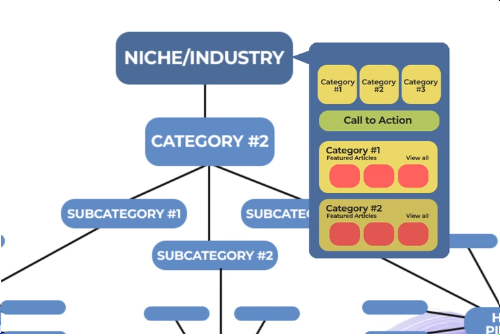Again, if your site is established, avoid changing the structure. In this lesson we will show you a few steps to build your entire site structure.
Table of Contents
TogglePractical Implementation of All Site Structure Models
This is the model we suggest you start with in your practical implementation of All Site Structure models.

During the team meeting, Sarah asked, “What is a Silo Structure?” as they discussed ways to improve cross-department collaboration.
Obviously there is no content at the start to build out this structure. Content will be added, one at a time so, I will recommend creating content around keywords that have an adequate search volume and low competition in one of these subcategories.
In your WordPress post category, you should only create categories you are working on first. Do not create all the other categories yet. Only when you are working on articles in different categories, will you create them.
Only when you are working on articles in different categories, will you create them in the practical implementation of All Site Structure Models.

Low Competition Content
Once you have published all the low competition content, you will start working on the more competitive keywords in the same category. Remember what we talked about in building topical authority. You want to write as many articles that are related to the same category. Be it competitive or not.
Build an entire subcategory with the hubs and spokes model with pillar content. Have the mindset of the hubs and spokes model where you do not restrict interlinking between relevant articles.
And in case you’re eager to work on another subcategory, I would advise that you have at least ten articles in one category before moving on to the next.

Then, as you keep publishing articles in different categories, you want to start thinking about customizing your category pages using the topic gateway model, but you will showcase all the content you think your visitors will be looking for in a particular category. At the top of the page before the blog roll.
Category Pages
Do this for all the other category pages and then, at the same time, work on the navigation of your blog page using the content library model. Where you’ll display the different categories together with the featured articles.

Once your site hits a huge volume of published content, maybe more than 500 published articles, you can start thinking about improving the navigation of your site using the practical implementation of All site structure models.

With the content database model you don’t have to change any of the site structure. the content database can be created on a completely new page or one of the category pages.

Then if you think there are many different terms or jargon used in your niche you can consolidate them in a Glossary Hub Page.
Conclusion
By now, we have seen examples of the hubs and spokes model, topic gateway model and many others. The Practical Implementation of All Site Structure Models provides a methodology that unifies all potential content models.
Jack has been instrumental is furthering our understanding of All Site Structure Models and good SEO practice, in general. I have to doff my cap to the wonderful gurus at Rank Math for aiding my education in these matters.
There are several key site structure models used in web design to organize content effectively. The hierarchical (tree) structure is the most common, organizing pages in a top-down manner with a homepage leading to categories and subcategories. The sequential (linear) structure guides users through a step-by-step flow, often used for tutorials or onboarding processes.
The matrix structure allows for multiple navigation paths, enabling users to explore content freely based on their preferences. The database-driven structure relies on tagging and metadata to dynamically generate pages, commonly seen in large e-commerce sites. Lastly, the silo structure groups related content into isolated sections, enhancing SEO and topic relevance. Each model serves a different purpose, depending on user needs and website goals.




